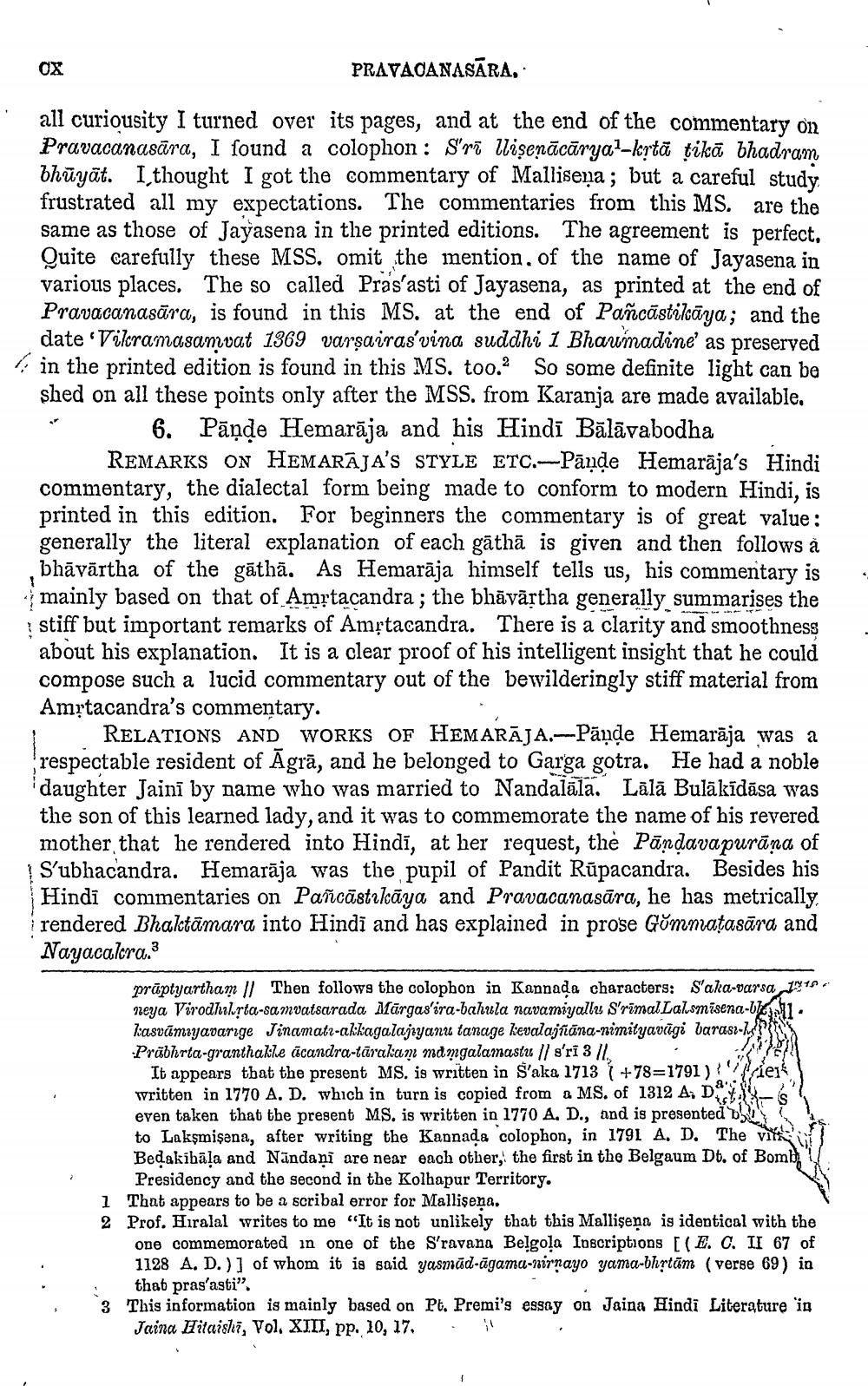________________
ox
PRAVACANASĀRA,
all curiousity I turned over its pages, and at the end of the commentary on Pravacanasāra, I found a colophon: S'rī llişenācārya?-krtā tikā bhadram bhūyāt. I thought I got the commentary of Mallisena; but a careful study, frustrated all my expectations. The commentaries from this MS. are the same as those of Jayasena in the printed editions. The agreement is perfect, Quite carefully these MSS. omit the mention of the name of Jayasena in various places. The so called Pras'asti of Jayasena, as printed at the end of Pravacanasāra, is found in this MS. at the end of Pañcāstücāya; and the date Vilcramasanvat 1369 varşairas'vina suddhi 1 Bhaunadine' as preserved in the printed edition is found in this MS, too. So some definite light can be shed on all these points only after the MSS. from Karanja are made available.
6. Pāņde Hemarāja and his Hindi Bālāvabodha
REMARKS ON HEMARĀJA'S STYLE ETC.-Pāņde Hemarāja's Hindi commentary, the dialectal form being made to conform to modern Hindi, is printed in this edition. For beginners the commentary is of great value: generally the literal explanation of each gāthā is given and then follows à ,bhāvärtha of the gāthā. As Hemarāja himself tells us, his commentary is mainly based on that of Amrtacandra; the bhāvārtha generally summarises the stiff but important remarks of Amặtacandra. There is a clarity and smoothness about his explanation. It is a clear proof of his intelligent insight that he could compose such a lucid commentary out of the bewilderingly stiff material from Amịtacandra's commentary. I RELATIONS AND WORKS OF HEMARĀJA.---Pāṇde Hemarāja was a respectable resident of Agrā, and he belonged to Garga gotra. He had a noble daughter Jainī by name who was married to Nandalāla. Lālā Bulākīdāsa was the son of this learned lady, and it was to commemorate the name of his revered mother that he rendered into Hindī, at her request, the Pāndava purāna of S'ubhacandra. Hemarāja was the pupil of Pandit Rūpacandra. Besides his Hindi commentaries on Pañcāstrkāya and Pravacanasāra, he has metrically, rendered Bhaltāmara into Hindi and has explained in prose Gömmatasāra and Nayacalcra, 3
prāptyartham | Then follows the colophon in Kannada characters: S'aka-varsa 2018 neya Virodhılsta-samvatsarada Mārgas'ira-bahula navamiyallu Srimal Lalsmisena-bell kasvāmiyavarige Jinamatu-alkagalajyanu tanage kevalajsilāna-nimityavīgi baras-2'58% Prõbhrta-granthakle ocandra-tārakam mdmgalamastu // s'ri 3 Il. .
It appears that the present MS. is written in S'aka 1713 (+78=1791 ) Priei ! written in 1770 A, D. which in turn is copied from a MS. of 1312 A, D 3 '! even taken that the present MS, is written in 1770 A, D., and is presented by to Lakşmişena, after writing the Kannada colophon, in 1791 A. D. The vi Bedakibāla and Nāndani are near each other, the first in the Belgaum Do. of Bomb)
Presidency and the second in the Kolhapur Territory. 1 That appears to be a scribal error for Mallisena. 2 Prof. Hiralal writes to me “It is not unlikely that this Mallişena is identical with the
one commemorated in one of the S'ravana Belgola Inscriptions [(E. C. II 67 of 1128 A. D.)] of whom it is said yasmād-āgamu-irnayo yama-bhrtām (verse 69) in
that pras'asti". 3 This information is mainly based on Pt. Premi's essay on Jaina Hindi Literature in
Jaina Hitaishi, Vol. XIII, pp. 10, 17. . !




